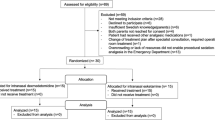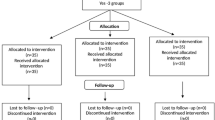Abstract
Objectives
Intranasal dexmedetomidine is a potentially effective anxiolytic but its role in pediatric laceration repair is only emerging. Future trials and clinical adoption of intranasal dexmedetomidine depend on understanding pediatric emergency providers’ practice patterns surrounding anxiolysis and perceived barriers to intranasal dexmedetomidine for anxiolysis during suture repair in children. Our objectives were to characterize these parameters to inform future research and facilitate clinical adoption.
Methods
We conducted an online survey of pediatric emergency physician members of Pediatric Emergency Research Canada from September to December 2020. Questions pertained to perceptions of anxiolysis for suture repair, with a focus on intranasal dexmedetomidine. The primary outcome was anxiolysis for suture repair. Data were reported using descriptive statistics.
Results
The response rate was 155/225 (68.9%). During suture repair, 127/148 (86%) believed that > 25% of young children experience distress requiring physical restraint. 116/148 (78%) would provide anxiolysis, mainly intranasal benzodiazepines (100/148, 68%). Only 6/148 (4%) would provide intranasal dexmedetomidine but 95/148 (64%) would consider it if there was evidence of benefit. The most common perceived barriers to intranasal dexmedetomidine included inadequate personal experience (114/145, 79%) and lack of access (60/145, 41%).
Conclusions
Most Canadian pediatric emergency providers believe that laceration repair in a young child is distressing. Despite questionable efficacy, most would provide intranasal benzodiazepines, but would consider intranasal dexmedetomidine if there was evidence of benefit.
Résumé
Objectifs
La dexmédétomidine intranasale est un anxiolytique potentiellement efficace mais son rôle dans la réparation des lacérations en pédiatrie n'est qu'émergent. Les futurs essais et l'adoption clinique de la dexmédétomidine intranasale dépendent de la compréhension des habitudes de pratique des urgentistes pédiatriques en matière d'anxiolyse et des obstacles perçus à la dexmédétomidine intranasale pour l'anxiolyse pendant la réparation des sutures chez les enfants. Nos objectifs étaient de caractériser ces paramètres pour éclairer les recherches futures et faciliter l'adoption clinique.
Méthodes
Nous avons mené un sondage en ligne auprès des médecins urgentistes pédiatriques membres de Recherche en urgence pédiatrique Canada (Pediatric Emergency Research Canada) de septembre à décembre 2020. Les questions portaient sur les perceptions de l'anxiolyse pour la réparation des sutures, en mettant l'accent sur la dexmédétomidine intranasale. Le résultat principal était l'anxiolyse pour la réparation des sutures. Les données ont été rapportées à l'aide de statistiques descriptives.
Résultats
Le taux de réponse était de 155/225 (68,9 %). Pendant la suture, 127/148 (86 %) ont estimé que > 25 % des jeunes enfants éprouvent une détresse nécessitant une contention physique. 116/148 (78 %) fourniraient une anxiolyse, principalement des benzodiazépines intranasales (100/148, 68 %). Seulement 6/148 (4 %) fourniraient de la dexmédétomidine intranasale, mais 95/148 (64 %) l’envisageraient s’il y avait une preuve de bénéfice. Les obstacles les plus fréquemment perçus à la dexmédétomidine intranasale étaient une expérience personnelle insuffisante (114/145, 79 %) et un manque d'accès (60/145, 41 %).
Conclusions
La plupart des fournisseurs canadiens de services d’urgence pédiatriques croient que la réparation des lacérations chez un jeune enfant est pénible. En dépit d'une efficacité douteuse, la plupart d'entre eux fourniraient des benzodiazépines intranasales, mais envisageraient la dexmédétomidine intranasale s'il était prouvé qu'elle était bénéfique.
Similar content being viewed by others
References
Spiro D, Zonfrillo M, Meckler F. Wounds. Pediatr Rev. 2010;31(8):326–34.
Neville DNW, Hayes KR, Ivan Y, McDowell ER, Pitetti RD. Double-blind randomized controlled trial of intranasal dexmedetomidine versus intranasal midazolam as anxiolysis prior to pediatric laceration repair in the emergency department. Acad Emerg Med. 2016;23:910–7.
Doyon-Trottier E, Doré-Bergeron MJ, Chauvin-Kimoff L, Baerg K, Ali S. Managing pain and distress in children undergoing brief diagnostic and therapeutic procedures. Paediatr Child Health. 2019;24(8):509–21.
Fein JA, Zempsky WT, Cravero JP. Relief of pain and anxiety in pediatric patients in emergency medical systems. Pediatrics. 2012;130(5):e1391–405.
Miller JL, Capino AC, Thomas A, Couloures K, Johnson PN. Sedation and analgesia using medications delivered via the extravascular route in children undergoing laceration repair. J Pediatr Pharmacol Ther. 2018;23:72–83.
Poonai N, Spohn J, Vandermeer B, et al. Intranasal dexmedetomidine for anxiety-provoking procedures in children: a systematic review and meta-analysis. Pediatrics. 2020;145(1):e20191623.
Conway A, Rolley J, Sutherland JR. Midazolam for sedation before procedures. Cochrane Database Syst Rev. 2016;5:CD009491. https://doi.org/10.1002/14651858.CD009491.pub2.
Ashley PF, Chaudhary M, Lourenço-Matharu L. Sedation of children undergoing dental treatment. Cochrane Database Syst Rev. 2018;12(12):CD003877.
Klein EJ, Brown JC, Kobayashi A, Osincup D, Seidel K. A randomized clinical trial comparing oral, aerosolized intranasal, and aerosolized buccal midazolam. Ann Emerg Med. 2011;58:323–9.
Bar-Meir E, Zaslansky R, Regev E, Keidan I, Orenstein A, Winkler E. Nitrous oxide administered by the plastic surgeon for repair of facial lacerations in children in the emergency room. Plast Reconstr Surg. 2006;117(5):1571–5.
Sulton C, McCracken C, Simon HK, et al. Pediatric procedural sedation using dexmedetomidine: a report from the Pediatric Sedation Research Consortium. Hosp Pediatr. 2016;6(9):536–44.
Gupta A, Dalvi NP, Tendolkar BA. Comparison between intranasal dexmedetomidine and intranasal midazolam as premedication for brain magnetic resonance imaging in pediatric patients: a prospective randomized double blind trial. J Anaesthesiol Clin Pharmacol. 2017;33:236–40.
Ghai B, Jain K, Saxena AK, Bhatia N, Sodhi KS. Comparison of oral midazolam with intranasal dexmedetomidine premedication for children undergoing CT imaging: a randomized, double-blind, and controlled study. Pediatr Anesth. 2017;27:37–44.
Surendar MN, Pandey RK, Saksena AK, Kumar R, Chandra G. A comparative evaluation of intranasal dexmedetomidine, midazolam and ketamine for their sedative and analgesic properties: a triple blind randomized study. J Clin Pediatr Dent. 2014;38(3):255–61.
Dillman DA. Mail and Internet Surveys. 2nd Edition. John Wiley & Sons Inc. (Hoboken, New Jersey). 2007.
Harris PA, Taylor R, Thielke R, Payne J, Gonzalez N, Conde JG. Research electronic data capture (REDCap)—a metadata-driven methodology and workflow process for providing translational research informatics support. J Biomed Inform. 2009;42(2):377–81.
Burns KE, Duffett M, Kho ME, et al. A guide for the design and conduct of self-administered surveys of clinicians. CMAJ. 2008;179(3):245–52.
Malia L, Laurich VM, Sturm JJ. Adverse events and satisfaction with use of intranasal midazolam for emergency department procedures in children. Am J Emerg Med. 2019;37(1):85–8.
Mellion SA, Bourne D, Brou L, et al. Evaluation clinical effectiveness and pharmacokinetics of atomized intranasal midazolam in children undergoing laceration repair. J Emerg Med. 2017;53(3):397–404.
Theroux MC, West DW, Corddry DH, et al. Efficacy of intranasal midazolam in facilitating suturing of lacerations in preschool children in the emergency department. Pediatrics. 1993;91(3):624–7.
Younge PA, Kendall JM. Sedation for children requiring wound repair: a randomised controlled double blind comparison of oral midazolam and oral ketamine. Emerg Med J. 2001;18:30–3.
Everitt IJ, Barnett P. Comparison of two benzodiazepines used for sedation of children undergoing suturing of a laceration in an emergency department. Pediatr Emer Care. 2002;18(2):72–4.
Kogan A, Katz J, Efrat R, et al. Premedication with midazolam in young children: a comparison of four routes of administration. Paediatr Anaesth. 2002;12:685–9.
Frey TM, Florin TA, Caruso M, Zhang N, Zhang Y, Mittiga MR. Effect of intranasal ketamine vs fentanyl on pain reduction for extremity injuries in children: the PRIME randomized clinical trial. JAMA Pediatr. 2019;173(2):140–6.
Poonai N, Canton K, Ali S, et al. Intranasal ketamine for procedural sedation and analgesia in children: a systematic review. PLOS ONE. 2017;12(3).
Xie Z, Shen W, Lin J, Xiao L, Liao M, Gan X. Sedation effects of intranasal dexmedetomidine delivered as sprays versus drops on pediatric response to venous cannulation. Am J Emerg Med. 2017;35:1126–30.
Qiao H, Xie Z, Jia J. Pediatric premedication: a double-blind randomized trial of dexmedetomidine or ketamine alone versus a combination of dexmedetomidine and ketamine. BMC Anaesth. 2017;17:158–65.
Cao Q, Lin Y, Xie Z, et al. Comparison of sedation by intranasal dexmedetomidine and oral chloral hydrate for pediatric ophthalmic examination. Pediatr Anesth. 2017;27(629–36).
Gan X, Lin H, Chen J, Lin Z, Lin Y, Chen W. Rescue sedation with intranasal dexmedetomidine for pediatric ophthalmic examination after chloral hydrate failure: a randomized controlled trial. Clin Ther. 2016;38(6):1522–9.
Miller J, Xue B, Hossain M, Zhang M-Z, Loepke A, Kurth D. Comparison of dexmedetomidine and chloral hydrate sedation for transthoracic echocardiography in infants and toddlers: a randomized clinical trial. Pediatr Anesth. 2016;26:266–72.
Kundu S, Achar S. Principles of Office Anesthesia: Part II. Topical Anesthesia. Am Fam Phys. 2002;66(1):99–102.
Baxter ALFR, Burke BL, Goldblatt SS, Isaacman DJ, Lawson ML. Local anesthetic and stylet styles: factors associated with resident lumbar puncture success. Pediatrics. 2006;117:876–81.
Friedrichsdorf SJ, Eull D, Weidner C, Postier A. A hospital-wide initiative to eliminate or reduce needle pain in children using lean methodology. Pain Rep. 2018;3:1–11.
Canadian Agency for Drugs and Technologies in Health. Dexmedetomidine for Sedation in the ICU or PICU: A Review of Cost-Effectiveness and Guidelines. Appendix 1. Cost Comparison of ICU Sedatives Ottawa, Ontario, Canada2014. https://www.ncbi.nlm.nih.gov/books/NBK268691/
Mindell JS, Coombs N, Stamatakis E. Measuring physical activity in children and adolescents for dietary surveys: practicalities, problems and pitfalls. Proc Nutr Soc. 2014;73(02):218–25.
Arts SE, Abu-Saad HH, Champion GD, et al. Age-related response to lidocaine-prilocaine (EMLA) emulsion and effect of music distraction on the pain of intravenous cannulation. Pediatrics. 1994;93:797–801.
Funding
Department of Paediatrics Resident Research Grant.
Author information
Authors and Affiliations
Consortia
Corresponding author
Supplementary Information
Below is the link to the electronic supplementary material.
Rights and permissions
About this article
Cite this article
Kumar, K., Ali, S., Sabhaney, V. et al. Anxiolysis for laceration repair in children: a survey of pediatric emergency providers in Canada. Can J Emerg Med 24, 75–83 (2022). https://doi.org/10.1007/s43678-021-00210-y
Received:
Accepted:
Published:
Issue Date:
DOI: https://doi.org/10.1007/s43678-021-00210-y




